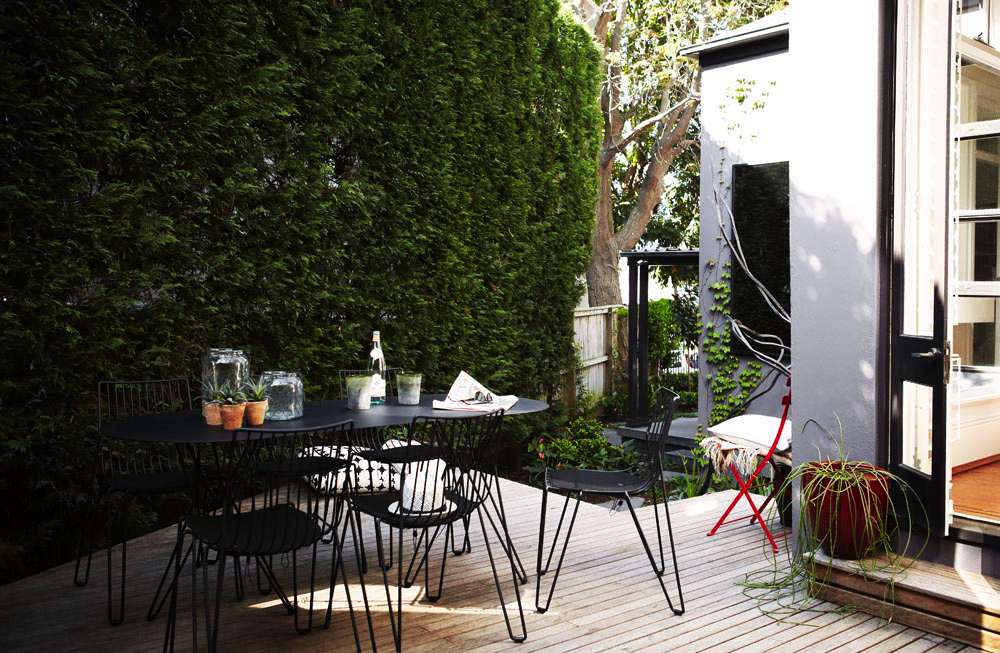Creating a small outdoor haven is not just about trying to make the space feel bigger. It involves gently integrating unique points of interest, awakening a sense of curiosity and creating connections.
Pepo Botanic Design’s Director, Nicola Cameron, shares her advice about how to develop a small garden to create a welcoming and inspirational space.

-
Create spaces within the space
Curves and nooks in a garden naturally entice us to look around the corner, discover hidden pockets and immerse ourselves in the experience. These design elements help to create interesting spots within the overall space.
Nicola Cameron says the options are plentiful when selecting punctuation points. “Courtyards or little balconies are often used to create an area of focus,” says Nicola. “A small water feature tucked behind a sweep of planting or a perfectly positioned chair to sit and enjoy the ambience will also evoke a feeling of presence and place.”

As well as being aesthetically pleasing, cosy pockets peak our sense of curiosity and discovery. They create a sense of purpose and provide an excuse to venture through the larger space and pause occasionally, to enjoy your surrounds.
-
Develop a spatial plan
A well-balanced space depends on a delicate balance of horizontal and vertical planes.
Utilizing height is a technique designed to draw the eye upwards and follow the lushness as it soars towards the sky, making an area feel much larger.

Vertical gardens can take a variety of forms and growing plants on a suspended panel helps to create the impression of elevation and abundance. A vined trellis and towering trees also coax the gaze higher and have the additional benefit of blocking out unsightly buildings or surrounding neighbours.
“Including interest above head height creates a sense of journey and volume,” says Nicola Cameron. “Don’t be afraid to partially block the view either. Peeking through a layer of raised greenery creates depth of field and the illusion of more space. A gentle breeze can also embellish the experience as the plants dance in the wind.”
It is equally important to achieve a balance between voids and mass on the horizontal plane. Allowing for open areas provides the opportunity for the garden to breathe. Rather than feeling vacuous, voids within the garden ruminate with generosity: a feeling that the expanse has the capacity to warrant areas that are free from a mass of planting and objects.
-
Integrate multi-functional areas
Small outdoor spaces often need to work hard.
One modestly sized area may have to perform a multitude of functions and thoughtful design is essential to creating a harmonious result. A rear inner-city courtyard might need to double as a car spot for example. Perhaps a narrow side garden has to harbour a clothesline, as well as taps and a ladder.

Identifying the practical requirements of a garden is the first step in successfully integrating a variety of functions.
Nicola Cameron regularly works with her clients to optimize their functional areas. “Some people require a living room arrangement and others need and dining spot with storage – all in the one area. Ensuring the space can accommodate different serviceable areas is crucial and needs to be carefully considered at the start of the planning phase.”
-
Harmonize tones
Connecting the elements is the key to seamless design.
Measuring less than 50m2, this courtyard in Bondi (pictured below) was created for entertaining. Harmonizing the various inclusions was essential to creating a place that felt comfortable. The garden area had to connect with the architecture and interior selections and most importantly, the overall design had to be well resolved.

Pepo’s design team began by understanding the function of the space before they started to tie the details together. Central to the plan was a complementary suite of colours and textures designed to connect the elements.
The silver hues of the benchtop were selected to visually link the BBQ and the grey tones of a patterned rug that sits under the dining table. Bright white chairs blend with the fenceline, cabinet cupboards and the perfectly formed stripe that wraps around a grey pot brimming with herbs, helps to unite the overall picture.
-
Select contrasting textures
Choosing a variety of contrasting plants significantly broadens an expanse by creating visual interest. With around 391,000 species of vascular plants known to science, the choices are extensive, and the textural diversity is vast.

Having the opportunity to draw on a large assortment of colours and textures gives a designer scope to select suitable plants for different sized gardens. It also provides the chance to alter perceptions, particularly in relation to depth of field.
A finer leafed plant such as an Acer palmatum (Japanese maple) for example, is more suitable in a smaller space that a heavier and darker leafed Magnolia tree. Similarly, a tapestry of Parthenese (Boston Ivy) contrasts beautifully with a swathe of palms or a distinctly structured succulent, such as Aloe Vera.
Pots and feature elements can also add interest to small gardens and companies such as Garden Life and Robert Plumb offer an extensive collection.
“Natural materials such as terracotta, stone and ceramics are currently trending,” says Nicola. “Textures and colours attract the eye and the use of contrasting pavers for example, can help to demarcate different living zones.”
-
Include a meaningful feature
Including a meaningful object in your space will entice you to venture outside and immerse yourself in your surrounds, whether your garden is large or small.
It might be an exquisite sculpture, a special table or a pot passed down through the generations that tells a particular story – bringing a smile and certain ease to your experience.

Integrating gentle lighting will bring your feature to life at night as well, and the lumination itself helps to create varying depths of field within the garden, adding another layer of enjoyment to your outdoor experience.
“Whether it’s a place to restore, or an environment of inspiration, points of interest and spatial planning will help to create a feeling of place and ease, in even the smallest of gardens,” says Nicola Cameron. “An intimate space provides a unique opportunity to nurture the mind and soul, in the cosiest of ways.”
Contact Pepo to discuss your garden design inspirations now.

